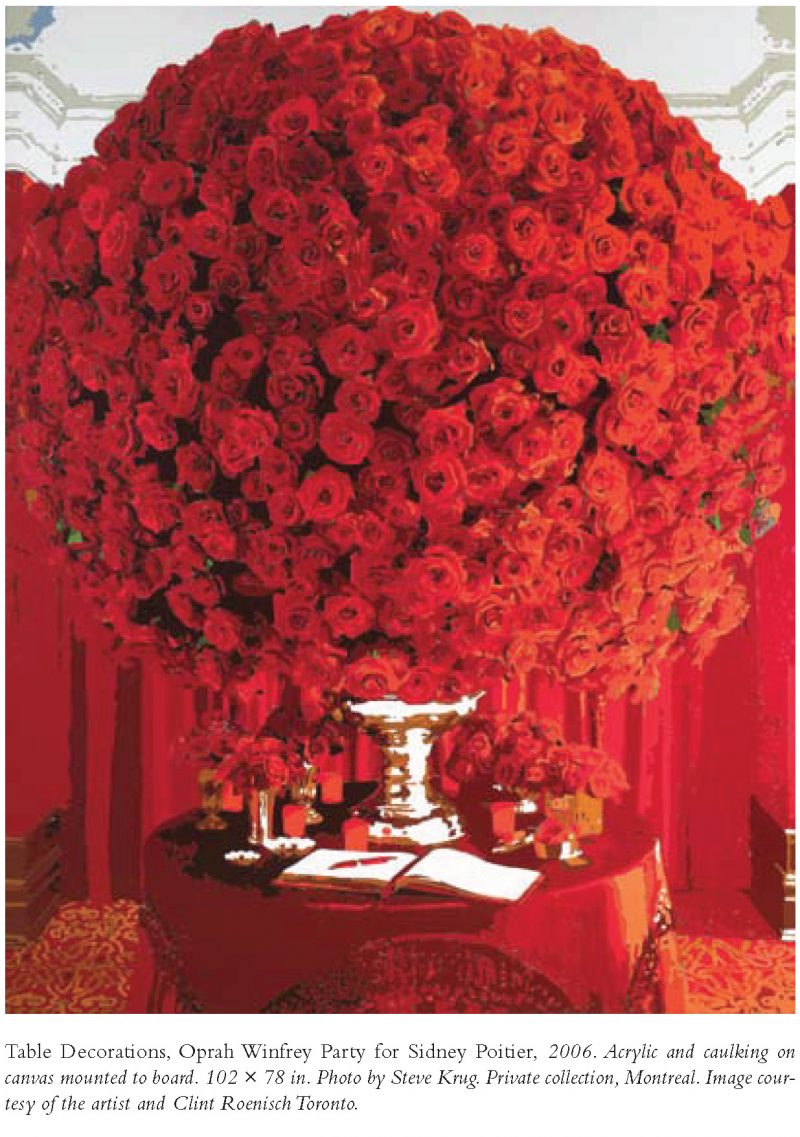For the first of our “The Process” columns, in which we talk to an artist about how they made a particular work of art, the Believer interviews painter Dorian FitzGerald about his Table Decorations, Oprah Winfrey Party for Sidney Poitier. FitzGerald’s past subjects have included a Fabergé egg, the throne room of the Queluz National Palace in Lisbon, and Elton John’s sunglass collection. We did this interview by Gchat one morning. He told me of how he exhibited the painting in a show he organized with two friends of his, who “left for overseas soon after.” FitzGerald was born in 1975 and has shown work in New York, Montreal, and Toronto.
—Sheila Heti
THE BELIEVER: Did you have any paintings in mind as inspiration when you were making this?
DORIAN FITZGERALD: No, nothing specific. Certainly, I have enjoyed paintings of flowers in the past—in particular, some of Odilon Redon’s pastel paintings. And I have always wanted to do a painting of flowers, as they have been a staple subject for artists throughout the ages.
BLVR: What is it about flowers that compels artists?
DF: For me, as I suspect for others, it’s partly a technical challenge—rendering from life, and getting the paint to be as compelling as one of nature’s most attractive creations. Of course, there’s the symbolic realm, too: roses are as loaded with symbolism as any other flower. These flowers are a table decoration from a party thrown by Oprah Winfrey for Sidney Poitier’s birthday.
BLVR: Where did you find the image?
DF: On a cover of O at Home.
BLVR: And when you saw it, did you immediately know it was something you wanted to paint?
DF: Yes, definitely. It was one of those lightning bolts— certainly one of the strongest I’ve ever felt. It was such a perfect summary of all of the concerns occupying my mind at the time. And I had been wanting to paint flowers for a while. So it was perfect.
BLVR: So part of your mind was kind of on the lookout for flower pictures?
DF: Yes. Let’s not talk about The Secret, ha.
BLVR: So you saw the magazine on a newsstand….
DF: Yes, while on lunch break, working at an art-supply store. I had no money on me, but a coworker, when he saw how excited I was, lent me the money so I could get it on the spot. I might have freaked him out a little bit.
BLVR: How soon after that did you start painting?
DF: There was a lot of photo-editing to do. It took a few months before I could start painting it in the flesh, and I was finishing another large project at the time. It was at the front of my mind, though, certainly.
BLVR: What do you mean by “photo-editing”?

DF: The process I use involves a fair amount of computer editing on even the simplest images, but with that one there were all of the usual elements of magazine covers that had to be removed: the masthead, cover lines. Architectural elements that were obscured that had to be cloned, created, and otherwise replaced, so much of the room and flowers are fictional. Then, painting it took about nine or ten months.
BLVR: How many different paintbrushes did you use?
DF: None! The paint is all poured. So I used many squeeze bottles.
BLVR: Oh! So do you make little outlines with glue or something, then pour the paint into the shallow capsules that are created? Up close, it looks almost like stained glass.
DF: It’s caulking—but adhesive caulking, so you are exactly right.
BLVR: And what kind of paint do you use? Is it very thick or very runny?
DF: Depends on where it needs to go. If it’s too runny it sometimes ignores the lines, and if it’s too thick it doesn’t go into the corners and may have a lumpy appearance when dried.
BLVR: How do you make the paint thicker or thinner?
DF: I use a pouring medium from Golden Paints. One of the benefits of working in an art store is getting exposed to the different material possibilities out there.
BLVR: Do you feel anything like “imagination” working when you paint from a source?
DF: I’m trying to document a lifestyle to which I don’t have access, so there is little opportunity to paint these scenes from life, yet the images of it dominate our media. So the act of filtering through the vast amount of images to select examples that best illustrate my concerns is probably where the act of “imagination” takes place—but many of the decisions made in rendering the work probably required imagination, too.
BLVR: Did you have to hurry to finish it for a show?
DF: Oh yes. The productivity curve goes up pretty sharply toward any deadline, and my particular painting process has a definite end point, so not finishing is really not an option. There are many creative decisions made in desperation.
BLVR: Can you remember one such decision?
DF: Well, the last thing to be finished was the tablecloth. I still hadn’t thought about how to render it, color-wise, and was desperately late. The painting actually wasn’t dry enough to be hung until two days after the show started! So it was a frantic repurposing of premixed paint, thrown in without studying any of my references. It’s not the most compelling part of the painting, to be sure, but it doesn’t attract attention to itself, either, so it worked out well.




